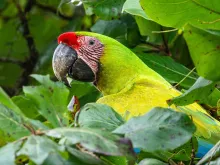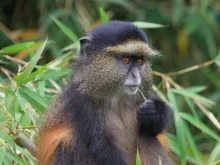Pelin Karaca, our Vice President of Product Development, is a longtime member of the Holbrook Travel staff who has visited numerous remarkable destinations across the world but only recently ventured into the Pantanal, Brazil’s sprawling and biodiverse wetlands, for the first time. She relayed stories from some of her encounters with the majestic wildlife and scenery of the largest tropical wetland in the world, which included participating in staring contests with jaguars, hearing earworm onomatopoeias from giant river otters, and embracing bird’s-eye views of Jabiru nests. In addition to observing and learning about capybaras, caimans, ocelots, Hyacinth Macaws, and Cocoi Herons from local expert biologists, Pelin spent time reflecting on the transformative nature of a trip like this. Continue reading to learn about everything that goes into traveling to the Pantanal and why this destination was chosen for one of our commemorative 50th anniversary trips.
 Pantanal Entrance
Pantanal Entrance
 Jaguar
Jaguar
Q: Pelin, what were your first impressions of Pantanal?
Pelin: We have been offering programs here for years, so I have been planning them and providing information to our leaders and participants, but I had never been there myself. I traveled with quite high expectations, and the trip delivered on all of them. People who have met me know I love East Africa – especially Tanzania – for the wildlife, so I wondered how similar this experience would be to that; and there was a lot of resemblance. In the tropics, we are so fortunate to see various species of birds and insects, but you have to work hard to see the bigger wildlife. On this trip, we had so many different birds and insects, and it was all topped off with jaguars, giant river otters, caimans, capybaras, and even an ocelot. Being from Florida, there was also a feeling of home, seeing caimans that resemble our gators, Cocoi Herons taking the place of Great Blue Herons, Snail Kites hovering above, and many more familiar faces. We were very lucky with our jaguar sightings. I have been hearing friends come back from Pantanal saying ‘We saw 15 different individuals, and these are their names.’ And it held true on every outing for us too. We understood why this part of the Pantanal is referred to as “Jaguarland.” We had Julia Munn, the daughter of conservation biologist Charles Munn, as one of our guides, and she was checking the jaguar database during our boat ride and introducing us to the individuals we were seeing. We met eight different jaguars, including Patricia’s two cubs that are going to be named pretty soon, so it was really cool.
 Caiman
Caiman
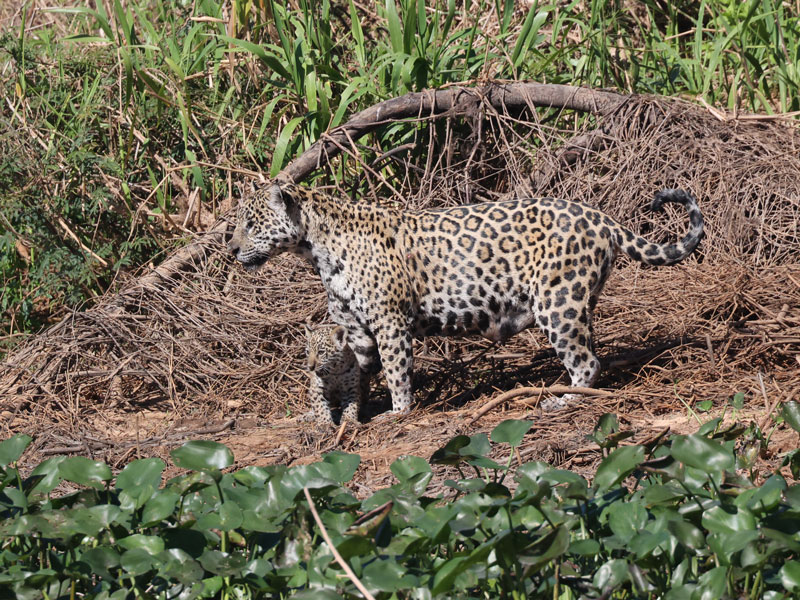 Jaguar with cub
Jaguar with cub
Q: Can you give us an overview of the trip?
Pelin: We all arrived to São Paulo on different flights from the States and connected with our domestic flight to Cuiabá, the capital of the Brazilian state of Mato Grosso and our gateway to the wetlands of the Northern Pantanal, where we spent our first night. Our next stop was Fazenda Santa Tereza, or SouthWild Pantanal Lodge, on the banks of the Pixaim River and the Transpantaneira Road, about three hours from Cuiabá. There will most likely be stops along the way as well. We spent four nights here - two at the beginning and another two at the end of our adventure. The lodge gave us the opportunity to explore the region both on land and on small boats. An additional two-hour drive on the Transpantaneira Road brought us to the port, where we transferred to the fast boats that took us to the Flotel & Jaguar Suites, which was our home for the following four nights. Once it was time to come home, we drove back to Cuiabá from SouthWild Pantanal for our flight back to São Paulo to connect with our flights home. You should have at least three to five nights here so you can guarantee seeing jaguars and have enough time to enjoy the experience fully, appreciating everything that the Pantanal offers. If you are into birding or photography, I personally suggest having at least five nights.
 Caiman encounter
Caiman encounter
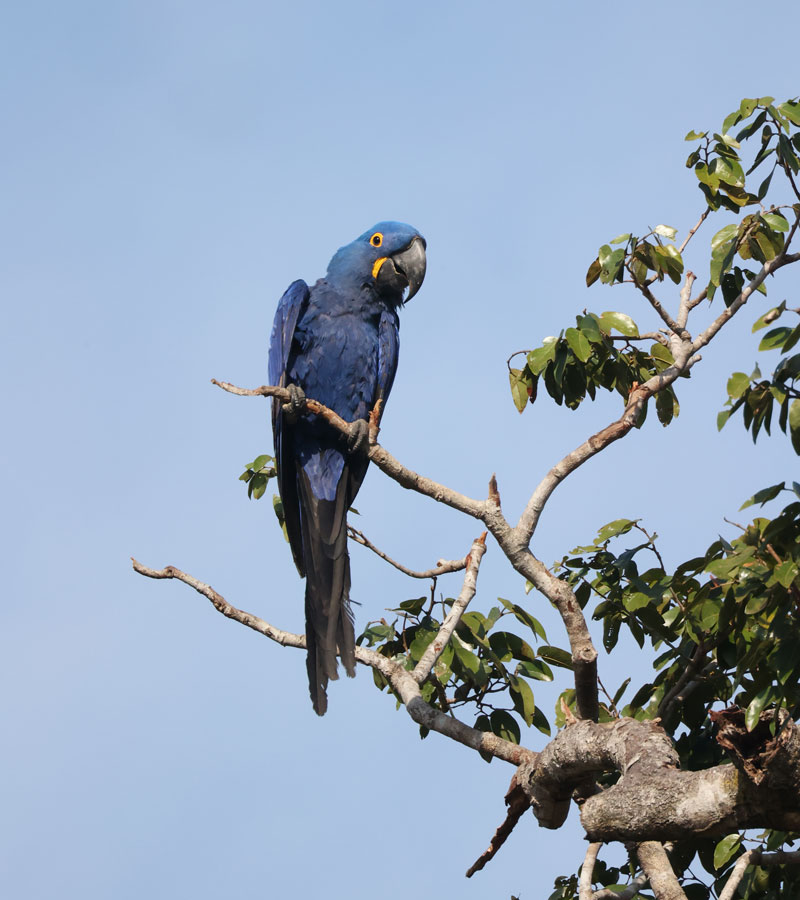 Hyacinth Macaw
Hyacinth Macaw
Q: What should travelers know about this destination? How strenuous was this trip?
Pelin: While we have our suggested program focusing on natural history, there are many ways we can customize the trip itinerary based on one’s interests, availability, and budget. The accommodations we had on our program were really comfortable and have A/C; however, this region is still isolated and tourism is limited compared to some other locations in Brazil. Due to the Pantanal’s unique environment, accessibility and roads can be challenging. People need to have a spirit of adventure and have some flexibility. You are really out in the elements. Infrastructure, as much as it is great now, is still limited. It is a region of Brazil that’s nothing like Rio de Janeiro or São Paulo, so being prepared is really important. It gets extremely hot and humid, and I say this as someone from Florida. You need to be careful about covering up from the sun. You still need to be prepared for cooler conditions, as early mornings – especially on boats – can be chilly, and if there is a cold-front coming, temperatures can sometimes drop below 40 degrees Fahrenheit. If you have back problems, those roads are going to test you. You sometimes spend up to five hours at a time driving along the Transpantaneira Road, which provides endless entertainment but is dusty and bumpy, and there's no avoiding that. If your back is a problem, don't be shy about bringing your back brace or pillows. If you value certain types of comfort, this is one program where you should read every bit of information and ask questions about things that are important to you, because they might not be available. There is a responsibility on the part of the travelers to this region to educate themselves.
 Transpantaneira Road
Transpantaneira Road
Q: Do you have a favorite or most memorable experience from the trip?
Pelin: All of it! But to narrow it down, I think seeing Stella, one of the eight jaguars we saw, was one of my favorites. We were on our boat, passing the same sandbanks we referred to as our homestretch, where Large-billed Terns and Black Skimmers were abundant, and enjoying the breeze. We made the familiar turn along the tributary, and through the vegetation and high grass, a head peeked out. We could have easily bypassed it. It was so close, and our two boats were the only ones there. Her name was Stella, and she just started walking on the riverbank. From time to time, she would stop, look at us, and continue. I really felt when she was looking at us, she was actually seeing us. I was mesmerized. The most fun I had was seeing the antics of the river otters. They were adorable and also scary – not a combination I often think together. I cannot get their sounds out of my mind; it’s as if they were laughing, screaming, or shouting. And well, I don't know if it's a good memory or not, but I don't like heights that much, and I climbed up a tower overlooking a Jabiru nest. That thing was high, and though quite secure, it would sway. I didn't know what to hold onto up there while trying to take pictures, but it was worth it. Being outside of your comfort zone is really good.
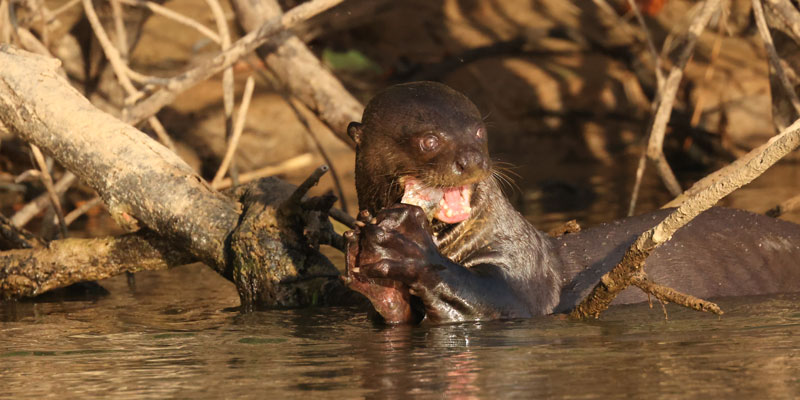 Giant river otter
Giant river otter
 Jabiru nest
Jabiru nest
 Jabiru
Jabiru
Q: Are there any activities or elements that you would like to highlight for their sustainable efforts?
Pelin: Maintaining a balance between tourism and conservation is essential with all natural ecosystems, but especially with one as delicate as the Pantanal. These wetlands provide habitat for lots of species, but also act as a major carbon sink and help regulate floodwaters. We make sure to choose field partners that prioritize sustainable practices to protect a region’s natural wonders, and that is the case with SouthWild, which has achieved carbon-neutral status due to their environmental and social practices. Additionally, because there are so many ranches around, if cattle escapes for whatever reason, jaguars might go after the cattle. The ranchers’ first instinct might be to shoot the animal, but a jaguar is worth way more alive than dead, in terms of the ecosystem but also in terms of the tourism dollars they bring to the local economy. So SouthWild Pantanal has an initiative that has been very successful where they put aside a fund to pay ranchers for losses to their cattle, so that the ranchers will leave the jaguars alone. They also employ members of the local communities to ensure there is support for their livelihoods and environmental education, so it’s a way to minimize any negative impacts from tourism and instead prioritize the health of the destination. And they also support important scientific research being done in the area, including interesting ocelot research.
 Pantanal Ranchers
Pantanal Ranchers
 Ocelot
Ocelot
Q: What surprised you the most about this experience?
Pelin: I have been so fortunate in my career. I love what I do, and Holbrook Travel has provided me so many opportunities to travel to amazing destinations and see wildlife up close. It shouldn't surprise me, but it still does. Every time, I am astounded by how close and intimate some of these experiences are. This trip added to that feeling. To top that, the diversity in Pantanal really blew my mind. Every day, there was a new adventure to be enjoyed and appreciated. The similarities between this wetland system and the Everglades, which I've only had the chance to visit once, made me reflect on the natural beauties surrounding us and the missed opportunities we have in our own backyards for connecting with nature. We are living stressful lives, and our brains are swamped with the constant stimulation we receive from every corner, making our current lifestyle not sustainable. It is very important that we prioritize time outdoors and connect with nature. It fills me with joy to see this beauty, but it also saddens me that as a species we are not doing our part to take good care of things. We are at every corner testing nature’s resilience. If everyone sharing these same sentiments made one change, things would be better, but I also believe there needs to be systematic change.

 Capybaras
Capybaras
Q: Why was Pantanal chosen as part of Holbrook Travel's 50th anniversary celebration? What makes it special?
Pelin: During our 50 years, Holbrook Travel’s main passion has been protecting natural resources and having people experience these wonders like we do. We have quite a lot of locations in Latin America that we support and love, and Brazil, for one reason or another, has not been in that mix frequently. It's the largest country in South America, so it has always been surprising to us that we aren't there more. Pantanal really reflects everything we stand for: protecting endangered species, endangered habitat, and people who care about similar things. So it was more of a ‘Why not?’ I mean, infrastructure in these locations is more difficult. Roads are not as smooth, and we have been traveling to Brazil for a very long time, so it's not a new destination. But we wanted to increase awareness among our participants as well. So if we put the program out there and have people visit, that word of mouth is our greatest tool. Pantanal certainly deserves it. For our 50th year, we wanted to celebrate Mrs. Holbrook in a way that shows we are still exploring and finding wonder. We still have that thirst for beauty and nature, and I cannot think of a better place than Pantanal, this gem in the middle of Brazil, to share that with others who have been sharing the same passion with us for these 50 years.
 Pantanal Sunset
Pantanal Sunset
To learn more and enroll in Holbrook Travel's 50th Anniversary Trip "Exploring Brazil's Pantanal" visit this page!





